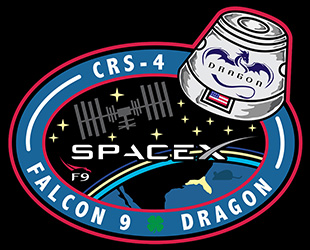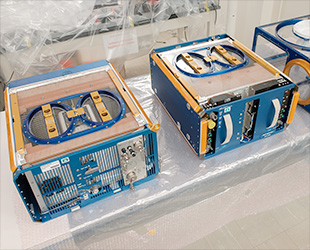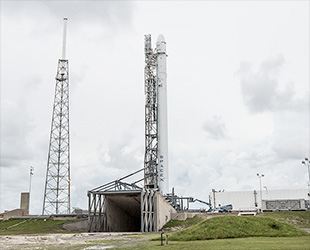September 21, 2014 — The mission patch for SpaceX's fourth NASA-contracted resupply flight to the International Space Station, which launched on Sunday (Sept. 21) from Florida, has everything you would expect from an emblem of its type, and something you might not.
Almost hidden among the patch's depictions of the Dragon space capsule, the orbiting laboratory and the Earth is a mouse. But that's because there are mice — 20 black, all-female mice to be exact — onboard the commercial cargo spaceship.
The "moustronauts" lifted off for the space station at 1:52 a.m. EDT (0552 GMT) onboard SpaceX's sixth Dragon to fly since 2010. Soaring to space atop a two-stage SpaceX Falcon 9 rocket, the Dragon's launch lit up the night sky as it climbed from Complex 40 at the Cape Canaveral Air Force Station.
The Dragon is expected to rendezvous with the station on Tuesday (Sep. 23), where astronauts will use the outpost's robotic arm to capture and berth the capsule for a month-long stay.

SpaceX's mission patch for its fourth Dragon supply flight to the International Space Station, CRS-4, on Sept. 21, 2014. (SpaceX) |
In addition to the mice, SpaceX's Commercial Resupply Services (CRS)-4 mission is bringing to the station a new device for monitoring ocean winds, an X-ray machine for measuring bone density, a commercial materials science study aimed at improving golf equipment, and the first 3D printer designed for use in microgravity.
Rodent research
The space station-bound mice will be the first residents of NASA's new Rodent Research habitat, which will be used to study their behavior and health. NASA's previous rodent astronauts, which flew on the space shuttle, rarely spent more than two weeks in space. This mission — primarily intended to test out the new habitat and hardware — will last 30 days.
"Never were we able to achieve a flight experiment of this duration, so we'll get some new information," Ruth Globus, project scientist for the rodent habitat at the NASA Ames Research Center in Moffett Field, California, said.
The four-month-old adult mice belong to a strain of inbred black lab mice known as C57 Black 6. Using cameras in the rodent habitat, scientists on the ground will be able to monitor the rodents' behavior in microgravity.
"Rodents don't just float around and have fun," explained Globus. "They tend to hold onto the walls."
"They move around a lot like monkeys do," she continued. "They run around. They're very physically active."
But that pattern of behavior could change the longer they stay in space, Globus said.

The Rodent Research Hardware System includes three modules: Habitat (left), transporter and animal access unit. (NASA) |
Astronauts lose muscle and bone strength in microgravity, and the same is expected for the mice. The rodents' loss in bone density will be measured throughout their mission using a new X-ray machine called the Bone Densitometer. Built by Techshot, the microwave-sized instrument is also onboard Dragon. It'll be the first X-ray source on the space station.
The mice won't be returning home alive; at the end of their — and the Dragon's — month-long stay at the station, the rodents will be euthanized and dissected by the crew so that certain of their parts can be frozen and preserved for study back on Earth. (Scientists are particularly interested in looking at the hind-leg muscles, liver and spleen.)
Science rising
The rodents account for only a small amount of the 5,000 pounds (2,270 kg) of supplies and payloads that launched aboard Dragon, including critical materials to support 255 science and research investigations that will occur during the space station's 41st and 42nd crewed expeditions.
Among the other payloads now heading for the station are Made In Space's 3D printer, Cobra Puma Golf's materials science investigation and RapidScat, a special radar that can peer through the clouds in the Earth's atmosphere and measure winds swirling over the ocean's surface.

RapidScat's two-part payload is shown in the trunk of the SpaceX Dragon at the Cape Canaveral Air Force Station, Fla. (SpaceX) |
"Unlike many optical satellites that can only see the top of the clouds, radar can really get to the bottom and see the wind speed and direction that affects the people on the ground," said Ernesto Rodr guez, principal investigator for the Rapid Scatterometer, or RapidScat, instrument.
Whereas scatterometers in the past flew in polar orbits, RapidScat will take advantage of the space station's orbit, which covers nearly every point of Earth at different times of day. This data will give forecasters insight into weather patterns, destructive hurricanes and ocean circulation.
The station's robotic arm — equipped with the Canadian Dextre robot and controlled from the ground — will take hold of RapidScat from Dragon's unpressurized trunk and install it on the outside of the European Space Agency's Columbus module.
Quick turnaround
SpaceX's launch of the CRS-4 Dragon on Saturday set a company record for the quickest turnaround, just 14 days since their previous Falcon 9 launch from the same pad. It also came close to the record for the Cape.

SpaceX's Dragon-capped Falcon 9 rocket at the Cape Canaveral Air Force Station's Launch Complex 40 prior to launch. (SpaceX) |
"I think the fastest one was in '65 or '67," said SpaceX's vice president of mission assurance Hans Koenigsmann. "In the future, actually, I anticipate this will be the norm. We are ramping up for that launch rate and actually even more than that."
Towards that goal, SpaceX again commanded its Falcon's first stage to perform a series of engine firings to attempt a "soft" splashdown after launching the Dragon. The fourth such attempt at recovering the stage, the company wants to eventually land it vertically on land and turn it around for reuse.
For now though, Koenigsmann said it's only an experiment and this first stage flew without the four legs deployed on two previous attempts.
Megan Gannon with Space.com contributed to this article.
